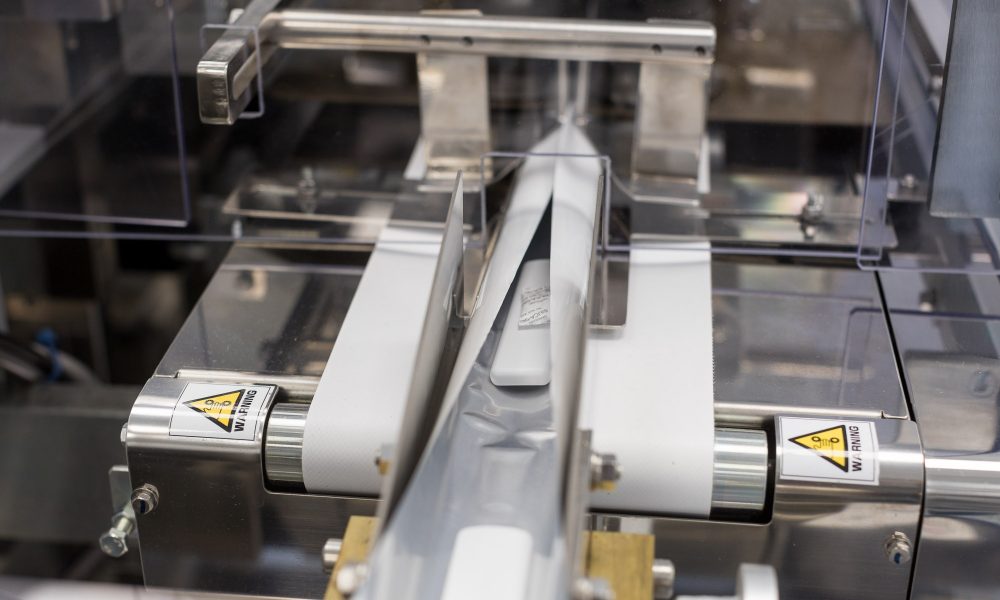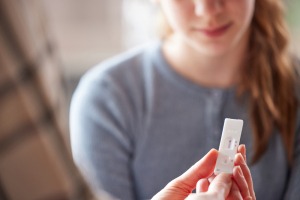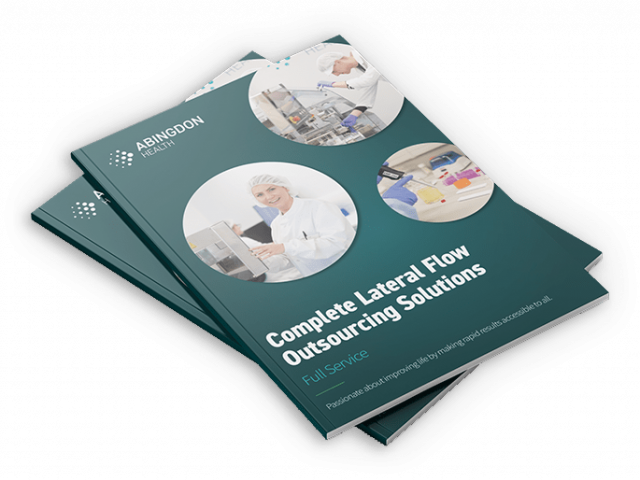Lateral Flow Market 2.0: Innovation and Growth in the Post-COVID-19 Diagnostics Market

In the first of a series of blogs around innovation, Abingdon Health’s CEO, Chris Yates, outlines some of the new developments within the lateral flow market that are driving a new phase of growth in this $10 billion global market and creating Lateral Flow Market 2.0.
Self-Testing Innovation: empowering us all to manage our own health
Labels: gold remains dominant, but other labels are attracting increasing interest
Molecular + Lateral Flow = Best of Both Worlds?
Digital Integration / Digital Capture: the future of lateral flow is digital
Key Take-Away
Lateral flow testing is over 30 years old; with the first (UK-developed) lateral flow pregnancy tests hitting the market in the 1980s. I’ve watched the lateral flow market expand significantly since then and have been excited by the broadening use of lateral flow technology across not only the clinical market but also into animal health, food, plant pathogen and environmental applications. One might argue that the industry had reached the maturity stage of an industry cycle by the 2010s, however, COVID-19 has had a dramatic impact, which I believe is leading to a further cycle of innovation and growth.
The use of COVID-19 rapid antigen tests massively expanded the use of these cost-effective and easy-to-use tests during the pandemic, therefore reducing the barriers to adoption as people became very familiar with the use of the technology. This means people not only feel comfortable testing themselves, but also they’re comfortable using lateral flow tests in other applications, whether it’s self-testing, testing animals, foodstuffs, plants, environmental applications or in other healthcare situations.
As we emerge from the COVID-19 pandemic, I believe we are seeing significant further awareness of, and expansion in, the use of lateral-flow tests; and the emergence of “Lateral flow Market 2.0” with this growth driven by Innovation, shifting the industry back into a phase of significant growth. A recent PwC study(1) highlighted that product innovation was a priority for 46% of all medical device companies; this was the highest percentage of any industry sector PwC reviewed.
As a dedicated lateral flow Contract Development and Manufacturing Organization (CDMO), Abingdon Health is at the forefront of many of the changes and the Innovation that the lateral flow industry is experiencing and below we highlight a number of areas where we are seeing new exciting developments.
Self-Testing Innovation: empowering us all to manage our own health
It may be unlikely that we’ll see again the scale of self-testing using lateral flow technology that we did during the pandemic. Estimates vary, but in the UK alone with a population of approximately 70 million, we saw procurement of over 1 billion lateral flow tests. So, the vast majority of the population performed self-testing and this self-testing “experiment” on a vast-scale has led to continued innovation in lateral flow self-testing technology to improve user experience.
Sample extraction and processing methodologies have been one interesting area of development; with more cost-effective components to improving the sample volume accuracy and reducing the number of operator steps, thereby reducing the potential for user-error. Another area we are seeing a great deal of focus is the increased use of saliva as the testing matrix. Finger prick blood or nasal-pharyngeal tests can be uncomfortable for the user and saliva can offer an easier-to-use method. Abingdon Health worked, and continues to work, closely with Oxford-based Vatic Health during the pandemic to develop a saliva-based COVID-19 rapid antigen test. The use of saliva is extending now into other large market opportunities, for example the fertility market. Abingdon Health has more than 20 years significant expertise in the use of saliva as a sample matrix for lateral flow tests and we are proud to support a number of innovative companies in the clinical sector bringing their products to market, drawing on the skills, experience and extensive knowledge of our personnel.
Labels: gold remains dominant, but other labels are attracting increasing interest
A continued drive to improve the performance of lateral flow tests has led to innovation in the use of different signal generators or labels. Traditionally, colloidal gold has been the label of choice and we have seen an expansion in the available of different sized gold particles and offshoots, such as gold nanorods. Gold nanorods – gold particles that have been elongated to resemble rods – rather than the traditional spherical shape, may be offered in different colours, which can allow increased multiplexing within lateral flow strips. In addition, we have seen increased interest in other labels. Fluorescence labels such as europium, which is used to produce time-resolved fluorescence, offer the potential for greater sensitivity. The drive for improved sensitivity has increased the use of fluorescence and this has also driven a growth in the availability of readers to measure the output. We are seeing the launch of readers that offer the potential to combine the reading of both fluorescence and colourimetric labels in one reader. Abingdon Health offers its partners expertise in reader development, manufacture and regulatory approval and has developed its own patented readers, including one incorporating time-resolved fluorescence and colourimteric reading.

Molecular + Lateral Flow = Best of Both Worlds?
Molecular testing and immunoassay lateral flow testing were traditionally seen as distinct segments of the diagnostic market. However, these lines are blurring and we are seeing many innovative companies looking at methods to combine the sensitivity of molecular techniques with the cost-effectiveness and ease-of-use of lateral flow immunoassays. We saw the emergence of these techniques through the pandemic. US company Detect Inc., launched a home-use COVID-19 test based upon this technology(2). The product is currently unavailable, but the potential for this technology integration is very real. In addition, companies such as Senzo(3) continue to push the boundaries of the use of this “PCR-Accurate Lateral Flow” technology in COVID-19 as well as into other infectious disease applications. In addition, food testing and animal health are both areas where this technology has broad application and Abingdon Health is supporting these efforts with its PCRD nucleic acid lateral flow assays, used for rapid readouts post isothermal amplification; and its PCRD customisation services.
Digital Integration/ Digital Capture: the future of lateral flow is digital
Digital solutions are becoming an important consideration in lateral flow developments, whether as part of a surveillance system or of a clinical pathway for example. Colourimetric readers have been used with lateral flow tests for a number of decades. Cozart plc, a UK company co-founded and managed by some of the Abingdon Health management team, developed hand-held colourimetric multiplex lateral flow readers based on charge-coupled device (CCD) technology for use with on-site saliva drug tests back in the late 1990s and 2000s(4). This found wide acceptance (and continues to do so as part of the Abbott portfolio) for point of contact drug testing in workplace, roadside, criminal justice and clinical environments. The technology has moved on in a number of ways since then.
Firstly, the size and cost of reader solutions have reduced significantly. Secondly various reading methodologies can now be combined into one reader, such as fluorescence and colorimetric reading as described above; thirdly reading technologies have also advanced with the use of optical processing alongside machine learning and AI to improve the accuracy of readers. And finally, smartphones readers, such as Abingdon Health’s patented AppDx® smartphone reader algorithms, have emerged as commercially viable solutions: the lateral flow reader in your pocket. Readers offer many advantages from reducing the subjectivity of reading test results, allowing non-visual labels such as fluorescence to be used and to capture, record and transfer data; and readers will play an increasing role in lateral flow development projects going forward.
The Key Takeaway: Lateral Flow Market 2.0: a testing revolution driven by Innovation and Integration!
We are in the midst of a second lateral flow market revolution and the emergence of Lateral Flow Market 2.0. Innovation is rife within the lateral flow market, driven in part by the impact of COVID-19 on the decentralization of testing; and this is growing the range of applications to which lateral flow technology can be applied. The Innovations above are not being performed “in isolation” and success will come from integrating a number of these innovations into one solution. It may well be that the “holy grail” is a saliva-based, one-step, home-testing, PCR-quality lateral flow system that is read with a smartphone and integrated with the clinical and treatment pathway; and we may not be as far away from this as you think! As a dedicated lateral flow CDMO Abingdon Health can support taking your product from “idea to commercial launch and success”.
Sources:
- indd (pwc.co.uk)
- https://detect.com/
- SENZO
- Cozart® RapiScan Oral Fluid Drug Testing System: An Evaluation of Sensitivity, Specificity, and Efficiency for Cocaine Detection Compared with ELISA and GC-MS Following Controlled Cocaine Administration | Journal of Analytical Toxicology | Oxford Academic (oup.com)

